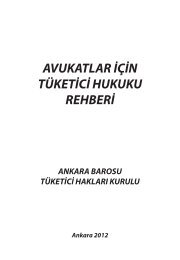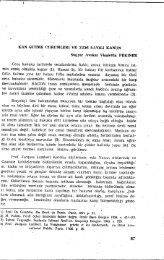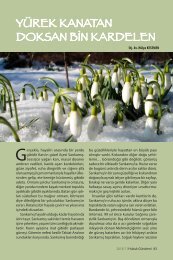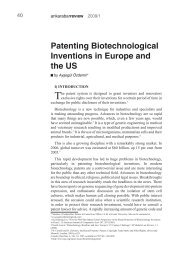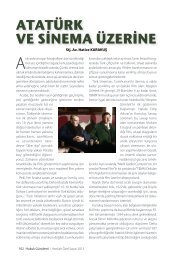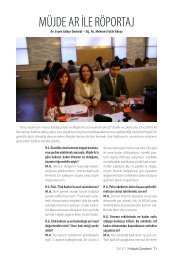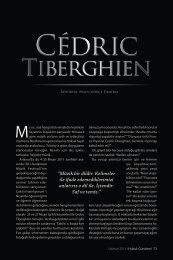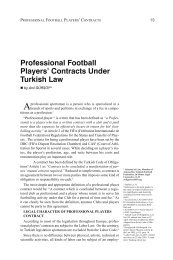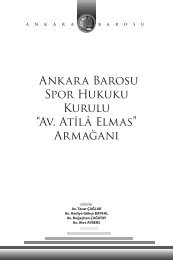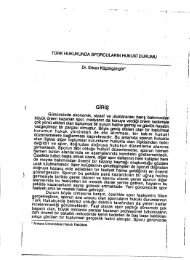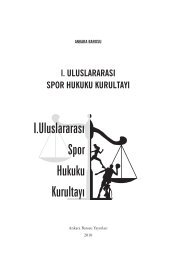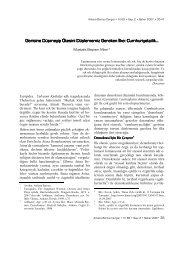The Turkish Cypriot Legal System from a Historical ... - Ankara Barosu
The Turkish Cypriot Legal System from a Historical ... - Ankara Barosu
The Turkish Cypriot Legal System from a Historical ... - Ankara Barosu
You also want an ePaper? Increase the reach of your titles
YUMPU automatically turns print PDFs into web optimized ePapers that Google loves.
100<br />
ankarabarrevıew 2010/1<br />
ye, Nicosia and doing sericultural business, was one party. <strong>The</strong> other<br />
party was a non-Muslim resident Nicola in Kafesli. In this case, Mehmet<br />
Efendi resorted to the local Kadi of Nicosia on the grounds that he<br />
had 36 kurus receivables <strong>from</strong> Nikola in consideration for the goods<br />
Mehmet Efendi sold to him (22 kurus for a mule, 10 kurus for two silk<br />
thread, 4 kurus as cash credit). Nikola denied Mehmet Efendi’s allegations<br />
and claimed that he performed his debt fully. However, this case<br />
was dismissed because Mehmet could neither prove his allegations<br />
nor accepted to take an oath before the Kadi. 42<br />
It is known that the <strong>Cypriot</strong>s also established a sort of “partnerships”<br />
on sericulture, leather trade, salt, sugar, dye and carpentry<br />
industries during the Ottoman era. 43 Inevitably some disputes arose<br />
<strong>from</strong> these commercial relationships. One of them concerns a partnership<br />
engaged in dyeing industry in Nicosia. One of the partners left the<br />
partnership after four years of its establishment and moved to Egypt.<br />
He then returned to the island and demanded of his “right/share” of<br />
eight years of receivables <strong>from</strong> the remaining partners. Upon the other<br />
partners’ rejection of his claim, he brought a lawsuit against the partners.<br />
<strong>The</strong> Kadi dismissed the case on the grounds that the plaintiff did<br />
not have any receivables due <strong>from</strong> the partners as he had left and dissolved<br />
the partnership in line with the other partners’ request. 44<br />
In another interesting case in 1709, El Hac Receb Aga, resident at<br />
Debbaghane, Nicosia brought an action of debt against Batino Loyizi,<br />
the priest of Istevaraoz Monastery. <strong>The</strong> plaintiff claimed that he lent<br />
160 kurus to Gavrayil, another priest of the same monastery, however<br />
the priest had died without paying his debt. When Receb applied to his<br />
heirs, i.e. the monastery, to collect his money, he was given a payable<br />
bill signed by Yankulu, the old priest of the monastery, to be paid to the<br />
monastery. However, Yankulu also died before clearing the bill, and<br />
that he had to take a legal action against Batino to collect his money.<br />
Batino acknowledged the debt, and asked for one year to pay it. After<br />
one year, Recep Aga again went before the Kadi asserting that he had<br />
only received cotton valuing 47 kurus in consideration for the debt,<br />
however he still had an outstanding amount. <strong>The</strong> defendant again acknowledged<br />
his debt, but rejected this claim and argued that the value<br />
of the cotton he gave to Recep Aga was not 47 kurus but 65 kurus, he<br />
gave 35 kurus worth of silk, and 127 kurus in cash. Thus in total he<br />
claimed that he already paid 227 kurus which was 38 kurus more than<br />
the total amount of his debt; thus he requested in the excess amount to<br />
be repaid to him. Recep Aga denied these claims. To prove his argu-<br />
42 For more details regarding the case see ÖZKUL, p. 219.<br />
43 For more infirmation see ERDOĞRU,A.: Kıbrıs’ta İlk Osmanlı Esnaf ve Zanaatkarları, Kıbrıs’ta Osmanlılar, Lefkoşa<br />
2008, p. 106 et seq.; ÖZKUL, p. 328 et seq.<br />
44 For more details see ÖZKUL, p. 208.



